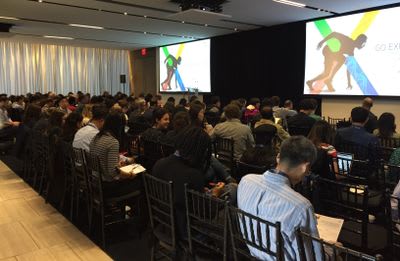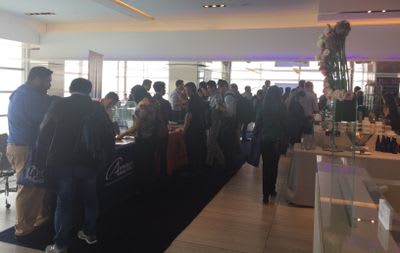Highlights from our New York City User Group Meeting

Our fourth North American UGM of 2018 was held on May 18th in New York, and we’re happy to report that it was packed, both with information and attendees! We were joined by more than 200 members of the 10x community. Guests heard presentations from 10x-perts, Giovanna Prout and Anushka Brownley, who updated everyone on our latest projects and showcased our bioinformatics software tools. At the end of the day, we gave attendees some extra insight into what’s been going on here at 10x, when everyone was invited to participate in our 10x-pert panel discussion. We’ll talk more about that later, but, first, we have to tell you all about the day’s featured presentations. We were lucky enough to get four 10x customers to share their fascinating research during the meeting.
Three of our presenters discussed the discoveries they’ve been making with the Chromium Single Cell Gene Expression Solution. First up, Dr. Rachel Bandler, MD/PhD Fellow at NYU School of Medicine and a member of the Lab of Gord Fishell, presented 'Developmental diversification of forebrain inhibitory neurons.' Dr. Bandler discussed exciting work recently published in Nature that provided the first evidence of postmitotic fate divergence in inhibitory neurons. Researchers used single cell RNA-seq (scRNA-seq) to investigate gene expression in inhibitory neurons in the developing forebrain. Using cell cycle genes, the investigators assigned a score to all cells to identify premitotic versus postmitotic cells. Gene expression in premitotic cells showed a conserved gene expression wave across regions of the forebrain, while postmitotic cells demonstrated clear fate bifurcations. Further analysis of single cell gene expression data from different developmental time points (embryonic to adult) allowed researchers to identify the transcriptional sequence into cortical interneuron subtypes at different developmental stages.
A presentation from Dr. Meizhen Zheng, The Jackson Laboratory, took the spotlight off single cell and shifted it over to the Chromium Genome Sequencing Solution. In 'Multiplex Chromatin Interaction Analysis with Single Molecule Precision,' she told us all about the research she’s been doing with Linked-Reads. Dr. Zheng described multiplex chromatin interaction analysis (Multi-ChIA), in which single chromatic complexes are segregated into droplets with gel beads, and the DNA associated with the chromatin complex is amplified and barcoded using the Chromium Genome Sequencing Solution (and modified protocol). This approach enables researchers to study co-transcription mechanisms with single molecule precision and detect multiplex chromatin interaction complexes. More information about this technique can be found in a preprint available on Biorxiv.
Then, Dr. Frederique Ruf-Zamojski, researcher in the Stuart Sealfon Lab at the Icahn School of Medicine at Mount Sinai, shared her single cell research, "Single-cell transcriptome dynamics in fresh and stabilized pituitary gonadotrope cells.' Gonadotrope cells are critical regulators of reproduction and are stimulated to produce gonadotropins by gonadotropin-releasing hormone (GnRH). Bulk RNA-seq experiments have shown that gonadotropin synthesis responds not only to to GnRH concentration, but also the frequency of GnRH concentration pulses. In this study, Dr. Ruf-Zamojski and team set out to use single cell gene expression analysis to help decode this frequency encoded stimulus. Due to the complex nature of the protocol design (time courses, multiple samples and treatments) and the transient nature of RNA, the researchers quickly realized they would benefit from a single cell stabilization reagent that would enable single cell transcriptomic experiments at a later time. This lead the team to develop RNA-Best, a reagent to stabilize individual cells from culture or tissue and preserve RNA.
After performing validation studies, the researchers used the Chromium Single Cell Gene Expression Solution to look at immediate early genes (IEGs) in fresh v. RNA-Best preserved cells for GnRH treated and untreated gondotrope cells. Dr. Ruf-Zamojksi and team identified cells in a different phases of the cell cycle and proportions of cells in each stage were similar for fresh and RNA-Best cells. Further, they were able to see that transcription of IEGs is not dependent on cell cycle stage. Despite having issues with gene drop out for some cell markers, the researchers are continuing to characterize gonodotrope cell responses to understand how these cells can decode frequency encoded signals.
Dr. Jihwan Park, Postdoctoral Fellow in the Katalin Susztak Lab at University of Pennsylvania, finished up our single cell genomics presentations with 'Single-cell transcriptomics of the mouse kidney reveals potential cellular targets of kidney disease.' Presenting his work from a recent Science publication, Dr. Park revealed a single cell atlas of a healthy mouse kidney, encompassing an impressive 43,745 cells. Analysis of the gene expression data revealed 16 clusters consisting of 3 novel kidney cell types and 8 sub-clusters. Looking closer at the data, researchers identified a renal collecting duct cell type that expressed both principal cell (PC) and intercalated cell (IC) markers. Pseudotemporal ordering of the these single cells using lineage tagging analysis revealed a novel transitional cell type by which PC and ICs turn into each other. Further gene expression analysis revealed that Notch receptor expression is sufficient to induce the PC cell state. Applying these learnings to chronic kidney disease (CKD) mouse models, researchers saw a conversion of IC to PC cells during kidney disease development (also in observed in 91 patients with CKD), implicating the loss of IC cells (associated with acid secretion in the kidney) as the likely cause of metabolic acidosis in mouse models and patients with CKD.

Attendees visit our partners Advanced Analytical, Miltenyi Biotec and Perkin Elmer.We ended the day with our favorite activity, the 10x-pert panel discussion, a forum that allows us to open up a dialogue with the 10x community. We’re always fascinated by the topics, questions, and concerns our attendees bring up, and today was no exception.
Thank you so much to everyone who helped make our New York UGM a success. And, for those of you who weren’t able to make it, don’t worry, you’ve still got more chances. We’ve got one more North American UGM on the agenda. We’ll be visiting Toronto on June 13th. Then, we’ll be going international, meeting some of our European community members in Paris on September 13th! Visit our UGM information page to register for a meeting near you. (Registration is Free!)
Additional Resources
-
Learn more about our gene expression and genomics solutions for:
-
de novo Assembly
Keep up to date on the latest 10x products including the new single cell products for CNV detection, ATAC-seq, and feature barcoding on our 10x Genomics website.
